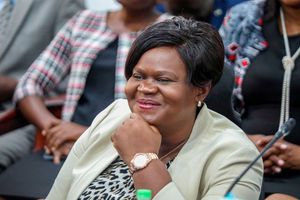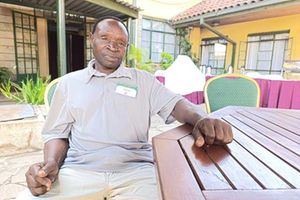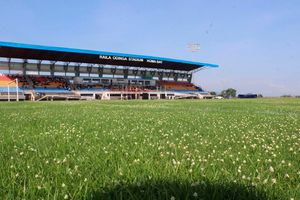
Raila Odinga Stadium in Homa Bay town.
A State committee has identified security faults that urgently need to be fixed at the Raila Odinga Stadium in Homa Bay Town, which will host the 2025 Madaraka Day on June 1.
This will be Dr Ruto’s second visit to the stadium, following an unannounced attendance of a football match in December 2024.
Sports Cabinet Secretary Salim Mvurya announced a Sh500 million budget for the project, which includes constructing new terraces to accommodate 10,000 spectators in addition to the existing 2,000-seat pavilion.
But for the National Celebrations Steering Committee, there is a lot more that needs to be done.
Anne Ngetich, the Principal Administrative Secretary in the Ministry of Interior, gave several recommendations to the construction workers currently expanding the sitting capacity of the stadium in ensuring the safety of the Head of State and other dignitaries who will be there on June 1 is not compromised.
"Let the work be done within the specified timelines and according to recommendations of the committee," she said.
One of the areas of concern that was noted was the height of the perimeter wall around the stadium.
In some sections, the wall is low and can easily be scaled by people from outside to gain entry into the facility using undesignated areas. It was recommended that the height of the wall be increased by at least one metre to promote controlled movement in and out of the stadium.
During the inspection, it was noted that the wall adjacent to the VIP section, where the main pavilion is, has openings that compromise privacy and safety of dignitaries, including the President.
It was designed in such a way that it has grills that let people from outside see what is happening within the parking lot at the stadium.
The wall separates the main pavilion and Rongo-Homa Bay road, which also has temporary structures along it that were flagged.
Upon entry in venues for national celebrations, the Head of State usually leaves his regular official car and boards an open ceremonial military vehicle with a bullet proof glass around him as he moves around when waving people.
Ms Ngetich said the wall should be reinforced with blinds so that whoever is outside does not see what is happening within the parking lot especially when the president changes vehicles.
“The whole area should be covered. The blinds should be from one corner of the wall to the other,” she said.
When beginning his movement around the main pitch in a military van, Dr Ruto is likely to face an obstacle.
Plans are that he will enter the arena from the left before going round the running track and alighting at the main pavilion and inspecting a guard of honour. As one gets into the pitch from the parking lot, a flood light restricts the entry space.
Ms Ngetich, who was accompanied by Nyanza Regional Commissioner Flora Mworoa and Homa Bay County Commissioner Moses Lilan, said the pole has to be pulled down.
“It will be taken to the furthest corner. There needs to be space where the president can easily pass through as he begins his movement around the stadium,” she said.
Some county government officials tried to oppose this and proposed that part of the pavilion be pulled down to create a pathway for the president.
But their suggestion was turned down by security officials, who said all national celebrations have standards and traditions — from the time the president gets into the venue, to the inspection of guard of honour, until he leaves the venue.
At the VIP area, the committee recommended that some seats that had been installed and used by spectators be temporarily removed to allow high ranking dignitaries to get sufficient sitting space.
The section has space where seats can be put up and used by high-ranking government officials. However, as the stadium will be hosting a national celebration, more government officers will attend and the space might not be enough for all of them.
There is an option of them using plastic seats installed around the VIP section.
But this would be inappropriate as the seats are designed in such a way that only sports fans can use them.
Some members of the committee said the seats do not befit a VIP section and should be removed.
Security officials also recommended that a clear boundary be put between the area where the president will sit and the where civilians will be.
It was also directed that a door be made near the VIP section to connect the areas and a waiting bay where Dr Ruto and other dignitaries can temporarily rest.
Currently, VIPs from the main pavilion at the stadium have to walk past a corridor to the edge of the building before getting into the waiting bay.
Their movement can easily be followed by people outside the stadium and security officers do not want to take any chances.
Ms Ngetich also recommended to the county government to put tiles made from decorative rocks in some areas around the VIP section.
“The walls around the stadium should have county government colours,” she said.
Some security officers are also interested in the movement of the president from the guard of honour inspection area to his seat.
At the stadium, the head of state will walk from the main pitch then make a turn, either left or right, before going up some steps to the VIP section.
Some officers proposed that the movement should be on a straight line from the pitch to the president's seat.
During the inspection, the committee was told that some sections of the main pavilion are used as offices.
One either side of the VIP section houses the sports and gender department offices on the first floor as well as the National Agricultural Value Chain Development Project (NAVCDP) offices on the ground floor.
Mr Mvurya, the Sports Cabinet Secretary, toured the site after the national celebrations steering committee had left.
He was accompanied by officials from Sports Kenya.
The CS said his visit to the site followed a directive from the President.
He said Dr Ruto had given orders for relevant state agencies to set aside funds and resources for expanding the stadium.
“The contractor has been working for six days now. I am here to officially hand over the site to the company,” the CS said.
According to Mr Mvurya, the stadium, which is under renovation, will be ready for use by mid-May.
“It will be used for Madaraka Day celebrations and sporting activities. Work will be done to the highest standards and completed within a record time,” Mr Mvurya said.
During construction, the CS asked the company at the site to consider hiring local residents to offer unskilled labour.
“We are also undertaking the expansion of other stadiums such as Bukhungu in Kakamega County,” the CS said.
Governor Wanga said she is grateful to Dr Ruto for selecting her county to host the forthcoming national celebrations.
She said the improvement of the stadium will be done to international standards.
“We will be able to host multiple sporting events here,” Ms Wanga said.







